So You’re the Rubber and I’m the Glue?

We need to start recognizing the presence of any disharmony in ourselves as being code for Not In Truth. If we’re paying attention, what we’ll notice isn’t just that we are experiencing a particular disharmony. We’ll realize that in some way, it has the same look and feel of something we’ve experienced before. Many times before.
This is caused by the fact that our mistaken beliefs about the world, which the Guide calls “images”, have a knack for drawing to us experiences that will seem to validate them—to make them appear correct. Their magnetic nature, while irritating on the surface of things, is part of the grand plan for us to bring our soul dents front and center for healing. Once we grasp this fact, we will change our perspective and go out in search of these patterns, for they reveal a lot.
The Guide’s suggestion for how to go about this excavation work is to do something called a Daily Review. At the end of each day, we only need to jot down a few notes about what we experienced that day: the feelings and associated thoughts. This isn’t the same thing as journaling. In this case, we want to be brief and to the point so that over time, we can look back through our collection of days and start to pick out the patterns. For we can’t fix what we can’t find.
Once we start to get the gist of what upsets our apple cart, we can start noodling around to find the phrase that resonates with us as being “the truth.” “I’m not enough and I’ll never be enough,” or “Everyone I love leaves me.” Our images won’t contain big, fancy words because they got created when we were very young. And they may be elusive to capture since we believe them—hook, line and sinker. This is why it is often not just helpful, but necessary, to be working with someone who is trained to spot images as they go flying by.

There is a particular kind of image, or belief, we need to go in search of, because it’s the one most responsible for our being handed a return ticket to this dualistic plane. We can call it our split. Keep in mind, we are each, at this point, a stitched together Frankenstein made up of many splintered-off aspects that are being loosely hung together to allow us to appear as a single form. Underneath all this fracturing and fragmenting, though, there is a core split in which we are literally torn in two by two opposing beliefs.
Generally speaking, we adopt one half of our split from our mother and the other half from our father. So for example, if a man has a father who was very demanding and yet always in competition with him, giving him the silent treatment if he ever seemed to outshine the father, he might conclude: “If I do well, I will be rejected.” Meanwhile, the mother was also demanding and highly critical anytime the man didn’t do something well, like getting good grades. So then the other half of the split would be: “If I don’t do well, I will be rejected.”
At the level of our split, we can’t win. We spend our lives in anxiety and turmoil, ping-ponging between two opposing beliefs that both lead to pain. This is an example of a dualistic trap we must bring all the way to the surface of our awareness so we can begin to catch it in action. Now, it might seem the work is simply the unearthing of the heart-rending misunderstanding contained in our split, bringing it into our conscious awareness. In fact, it is only at this point that our real work begins. For just because we are aware of a mistaken belief, that doesn’t stop it from operating.
First, be aware there is a very real tendency for us to bring an image or split into our awareness, only to lose a grip on it and have it slip back into the black sea of our unconscious. So word to the wise, if something comes up, write it down in black and white. Get to know it. Start to look for where it shows up, and be prepared to start seeing it everywhere. Because our hidden beliefs have a pervasive effect throughout our lives; they are ubiquitous and insidious.
Second, realize this: our images aren’t the real cause of all our ills, our Lower Self is. And our Lower Self is just using our images for it’s wicked games of hide-and-go-away. The work lies in our willingness to die into our mistaken beliefs and wrap our arms around the reality that we have been wrong. Knowing the truth—both of who we are, and of any situation in our lives—takes away the wedge the Lower Self was leveraging to keep us separate.
In the example given, what we need to also uncover is the truth: neither of these things is true. We are lovable and we are loved, not only by God but also by our own Higher Self and other people in our lives—albeit imperfectly. And no matter what we do or don’t do, we can’t ever be rejected from the Kingdom of Heaven, for that is our true home. We’ve just forgotten this.
We have spent our lives resisting and avoiding, behaving in ways we hope will prevent ever again experiencing the feeling of humiliation. We must come to see that humility, in fact, is the pathway to the divine. And we must become willing to give up our wrong position that says, “But this is how it is. And based on this, I need to continually defend myself, so I stay safe.”
If our hidden beliefs were true, this would make sense. But they are not true and our lives are less satisfying for them. For they cause us to spend our days in a perpetual crouch, tilting at windmills and behaving in ways that make people respond from their own negativity, which only makes it seem true we needed to keep our weapons half-cocked.
In Jill’s Experience
Over the course of doing my work, I have surfaced a number of images, or mistaken beliefs, which act like truths that become self-evident. Our lives become these ongoing dramas in which we recreate the offending “truth”, only to inwardly writhe in anguish over how painful it is to keep doing so. In a nutshell, that’s how this whole humanity thing works.
A few of my images are:
- I’m not enough and I’ll never be enough.
- People intend to be mean to me.
- I didn’t make the cut.
So when I don’t get recognized at work for my contribution, that will butt up against my belief this was intentional, because people, I believe, intend to hurt me. Further, it underscores my belief “I’m not enough.” At that point, believing “and I’ll never be enough” is just piling on. It’s like basically saying this pain will go on forever, and indeed, that’s how it has felt.
It has also been uber-helpful for me to uncover my split. This happened while I was essentially journaling, although at the time, I had the intention of venting my spleen to my Helper about something that was eating me up. Regardless, while writing, I managed to catch a thread from my Higher Self, and found myself writing out my split.
First was the part about the pain I experienced when I was seen. I was raised in a Midwest farming community, and while I personally had never lived on a farm, I had relatives who farmed and both of my parents had been raised on farms. If I had to summarize my take on things it would be this: if I was seen, I was put to work.
Now, for a lot of farming families, that’s how things are. Yet that doesn’t mean everyone who grows up on a farm has a bad reaction to this. Our take on things may or may not be a match for the reality of what happened, and that’s OK. What matters is our take. This is the environment that brought my soul dent up to the surface.
I hated feeling I was only appreciated for my contribution to housework. So for me, if I was seen, it hurt. As a result, I developed a way of cloaking myself so I could show up in life and actually not be seen. One can imagine how that might create a conflict regarding the other side of my split—the thing I got from my other parent—which was the feeling of not being seen. And of course that hurt.
The truth about our split is it’s a needle we can never thread. The only way out is to just die into the pain of it. When something rubs me the wrong way, I need to pause and ask myself: is the problem here that I don’t like the way I’m being seen? Or do they simply not see me?
As I have discovered, by doing my work of healing, I can release the residual pain tied up in my inner contradictions. One could argue this won’t change much, but in fact it changes everything. It changes how I feel about the world, letting go of my case that “the sons-a-bitches are out to get me.” And perhaps most importantly, it makes me curious about what’s up with the other—what’s making them act as they do?
Ten out of ten times, the other person is a human being who has images of their own. When our images are charged with tension, we magnetically attract people to us who have matching images that will strike a chord with ours. This is God at work, helping us see what we must in order to heal what we came here to work on.
In Scott’s Experience
The thing about images I can’t say strongly enough is that they are unconscious beliefs. The thing about unconscious is that most often you have no idea of it. In fact, images are often buried so deeply you can often only first find them indirectly, from the outer evidence of life. Even in writing about my images I wonder if anyone would seriously believe this coming from a fairly normal, competent human being. Yet talking with many peers on the path, they too have found crazy beliefs in there. That said, shocking as they may seem at first to the conscious mind, once an image surfaces, we also realize it’s what we have long believed to be true, albeit unconsciously.
In the first chapter, I wrote about an image I found: “If I am strong, I will be loved.” I think this one became set around age 13, during a difficult time in my life following the death of my mother. Well, it gets even more interesting…
Growing up I had one nagging, won’t-ever-go-away health challenge related to my sinuses. Starting at a really young age, like before age two, I had terrible sinusitis. I was put on prescription decongestants almost year round in order to keep my nose clear. A couple times every year I would develop full bronchitis and have a few weeks of misery.
None of my doctors could find anything wrong. I was allergy tested a few times, always coming back negative to everything. I even had my sinuses scoped once, hoping they would find something up there, like maybe a pencil eraser from the late 60s or a Hot Wheels car tire. It continued into adulthood, and I thought it was just my lot in life.
Then in my early 30s I started getting some clues that sinus congestion wasn’t just a random thing, nor was it purely a medical condition. After all, I had some periods of a few months with completely clear sinuses. I began to get curious about what could actually be driving this. I began stacking up all the clues in my life, of when I was breathing clear and when it changed back, of when it stayed a low level of clogged and when it developed into sinusitis. And I began praying to know the truth.
Then one day I had a powerful knowing that I held a hidden belief: “If I am sick, I will be loved.” I was shocked. I was also confused, due to my opposing image: “If I am strong, I will be loved.”
So part of me was driven to be strong, to keep with my Ironman training. And just when I would get strong, the other part would kick in and I would become sick. This would set back my training. My belief that I must be strong to be loved would foil the part of me that intended to be sick. And the belief that I must be sick to be loved would foil the part of me that intended to be strong. Around and around I would go. I shake my head thinking about it.
And yet it’s only through a process of deep listening—and not judging—that the clues to the next stage of healing arise. I came to realize that as a toddler, I would stop breathing or pant with shallow breaths. When I still did that as an adult, I simply wasn’t moving air, or chi, up high into my lungs, and they would clog up. When I changed those things, my lung function improved dramatically.
About six months into my relationship with Jill, we had a fairly major issue surface and in the middle of our struggles, my lungs went into spasm. I was in pain for days with a deep ragged cough, even after we had resolved our difficulty. To my body, I was re-experiencing an old trauma and my habitual way of coping and reacting kicked in. Healing can be a long and painstaking process.
Next Chapter
Return to Doing the Work Contents


